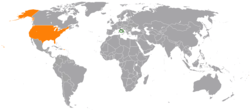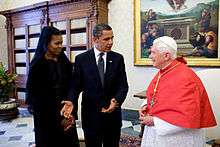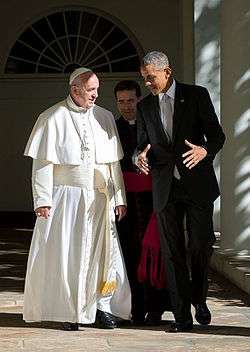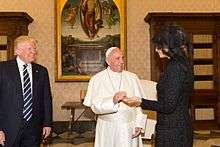Holy See–United States relations
United States–Holy See relations are bilateral relations between the United States and the Holy See. The principal U.S. official is Ambassador Callista Gingrich, who officially started at her position on December 22, 2017. The Holy See is represented by its Apostolic Nuncio, Archbishop Christophe Pierre, who assumed office on April 12, 2016. The U.S. Embassy to the Holy See is located in Rome, in the Villa Domiziana. The Nunciature to the United States is located in Washington, D.C., at 3339 Massachusetts Avenue, N.W.
 | |
Holy See |
United States |
|---|---|
History
1797–1867
The United States maintained consular relations with the Papal States from 1797 under President George Washington and Pope Pius VI to 1867 and President Andrew Johnson and Pope Pius IX. Diplomatic relations existed with the Pope, in his capacity as head of state of the Papal States, from 1848 under President James K. Polk to 1867 under President Andrew Johnson, though not at the ambassadorial level. These relations lapsed when on February 28, 1867 Congress passed legislation that prohibited any future funding to United States diplomatic missions to the Holy See. This decision was based on mounting anti-Catholic sentiment in the United States,[1] fueled by the conviction and hanging of Mary Surratt, a Catholic, for taking part in the conspiracy to assassinate President Abraham Lincoln. Her son, John Surratt, also Catholic, was accused of plotting with John Wilkes Booth in the assassination. He was given sanctuary by the Roman Catholic Church and fled to Italy where he served as a Papal Zouave. There was also an allegation that the Pope had forbidden the celebration of Protestant religious services, previously held weekly in the home of the American Minister in Rome, within the walls of the city.[2]
1867–1984
From 1867 to 1984, the United States did not have diplomatic relations with the Holy See. Several presidents designated personal envoys to visit the Holy See periodically for discussions of international humanitarian and political issues. Postmaster General James Farley was the first of these representatives. Farley was the first high ranking government official to normalize relations with the Holy See in 1933 when the Postmaster General set sail for Europe, along with Soviet Commissar of Foreign Affairs Maxim Litvinov on the Italian Liner SS Conte di Savoia. In Italy, Farley had an audience with Pope Pius XI, and dinner with Cardinal Pacelli, who was to succeed to the papacy in 1939.[3] Myron Charles Taylor served Presidents Franklin D. Roosevelt and Harry S. Truman from 1939 to 1950.[4]
Presidents Nixon, Ford, Carter, and Reagan also appointed personal envoys to the Pope. Also, all of these presidents, in addition to Truman,[5] Eisenhower,[6] Kennedy,[7] Johnson,[8] and all later presidents, along with the first ladies clad in black dresses and veils, have sought the papal blessing, typically during the first few months of their administrations, and usually traveling to the Vatican to do so.[9][10][11][12][13][14][15][16][17][18][19]
On October 20, 1951, President Truman nominated former General Mark W. Clark to be the United States emissary to the Holy See. Clark later withdrew his nomination on January 13, 1952, following protests from Senator Tom Connally (D-TX) and Protestant groups. The official prohibition lasted until September 22, 1983, when it was repealed by the "Lugar Act".[20]
The Vatican has historically been accused of being un-American, at least until the presidency of John F. Kennedy (see Americanism (heresy), nativism and anti-Catholicism in the United States). The bulk of the accusation is found in Paul Blanshard's book American Freedom and Catholic Power, which attacked the Holy See on grounds that it was a dangerous, powerful, foreign and undemocratic institution.
1984–present


The United States and the Holy See announced the establishment of diplomatic relations on January 10, 1984.[21][22] In sharp contrast to the long record of strong domestic opposition, this time there was very little opposition from Congress, the courts, and Protestant groups.[23] On March 7, 1984, the Senate confirmed William A. Wilson as the first U.S. ambassador to the Holy See. Ambassador Wilson had been President Reagan's personal envoy to the Pope since 1981.[22] The Holy See named Archbishop Pio Laghi as the first Apostolic Nuncio (equivalent to ambassador) of the Holy See to the U.S.[22] Archbishop Laghi had been Pope John Paul II's apostolic delegate to the Catholic Church in the United States since 1980. Relations between President Ronald Reagan and Pope John Paul II were close especially because of their shared anti-communism and keen interest in forcing the Soviets out of Poland.[24] Also, the two men forged a common bond over having survived assassination attempts just six weeks apart in the spring of 1981.
Following the September 11 attacks and the beginning of the US war on terrorism from 2001, the Vatican has been critical of the war on terrorism in general, and particularly critical of the US policies in Iraq.[25] On July 10, 2009, President Barack Obama and Pope Benedict XVI met in Rome.[26] A planned relocation of the U.S. embassy to the Holy See to the same location as the U.S. embassy to Italy drew criticism from several former U.S. ambassadors.[27] On March 27, 2014, Obama and Pope Francis met in Rome; this was followed by Pope Francis's 2015 visit to North America in September 2015, where, after visiting Cuba, he came to the U.S., and participated in the World Meeting of Families in Philadelphia, and also visited Washington, D.C., and New York City.[28]

In June 2015, the United States and the Holy See concluded their first inter-governmental agreement which aims at curtailing offshore tax evasion through automatic exchange of tax information.[29]
See also
References
- Melady, Thomas P.; Stebbins, Timothy R. (Spring 2009). "US-Vatican Relations: 25th Anniversary and a New President". The Institute of World Politics. Archived from the original on January 16, 2014. Retrieved May 1, 2011.
- Nicholson, Jim (2004). "The United States and the Holy See: The Long Road". Legionnaires Praying for the Clergy Apostolate. Archived from the original on May 27, 2007.
The critics finally won out in 1867 when Congress withdrew all funding for the legation in Rome. The apparent reason was a rumor relating to the religious freedom of Protestants in the Papal States. From the beginning of the legation in Rome, Papal authorities had allowed the celebration of Protestant religious services in the home of the American Minister. When the services grew, they were moved to a rented apartment under the seal of the American Legation to accommodate the participants. The news floating around Washington and being reported in the New York Times was that the Pope had forced the protestant group outside the walls of Rome. This, according to Rufus King, the American Minister himself, was untrue in its entirety.
- Farley, James (1948). Jim Farley's Story: The Roosevelt Years. New York City: McGraw Hill. ISBN 978-1430450610.
- John S. Conway, "Myron C. Taylor's Mission to the Vatican 1940–1950." Church History 44.1 (1975): 85-99.
- "The Trumans Meet the Pope During Vatican Visit; Truman in Cutaway Coat". New York Times.
- "Travels of President Dwight D. Eisenhower". U.S. Department of State Office of the Historian. Archived from the original on December 4, 2011.
- "Travels of President John F. Kennedy". U.S. Department of State Office of the Historian. Archived from the original on December 4, 2011.
- "Pope Paul VI Visit to the United Nations, 1964". Vatican.va. Archived from the original on March 17, 2013.
- List of meetings between the Pope and the President of the United States
- "Travels of President Richard M. Nixon". U.S. Department of State Office of the Historian. Archived from the original on December 4, 2011.
- "Travels of President Gerald R. Ford". U.S. Department of State Office of the Historian. Archived from the original on December 4, 2011.
- "Holy See Press Office - His Holiness Pope John Paul II Biography". Vatican.va. Archived from the original on November 7, 2011.
- "Travels of President Ronald Reagan". U.S. Department of State Office of the Historian. Archived from the original on December 4, 2011.
- "Travels of President George H.W. Bush". U.S. Department of State Office of the Historian. Archived from the original on December 4, 2011.
- "Travels of President William J. Clinton". U.S. Department of State Office of the Historian. Archived from the original on December 4, 2011.
- "Travels of President George W. Bush". U.S. Department of State Office of the Historian. Archived from the original on December 4, 2011.
- "Obama holds first talks with Pope". BBC News. July 10, 2009. Archived from the original on March 17, 2013. Retrieved August 2, 2010.
- Wooden, Cindy (July 10, 2009). "Presidents and popes: Obama is 12th US president to visit Vatican". Catholic News Service. Archived from the original on March 17, 2013. Retrieved October 25, 2010.
- "Trump 'determined to pursue peace' after Pope meeting". BBC News.
- "Religion: Recognition for the Holy See". Time. December 26, 1983. Archived from the original on October 4, 2014. Retrieved May 1, 2011.
- "Bilateral Relations of the Holy See". Vatican.va. 2014. Archived from the original on July 9, 2014.
- "U.S. Relations With the Holy See". United States Department of State. October 31, 2013.
- Andrew M. Essig, and Jennifer L. Moore. "US-Holy See Diplomacy: The Establishment of Formal Relations, 1984." Catholic Historical Review (2009) 95#4, pp. 741-764741-764. online
- Marie Gayte, "The Vatican and the Reagan Administration: A Cold War Alliance?." Catholic Historical Review (2011) 97#4 pp. 713-736 online
- Teslik, Lee Hudson; Johnson, Toni (July 14, 2009). "U.S.-Vatican Relations". Council on Foreign Relations. Archived from the original on September 3, 2013. Retrieved October 4, 2014.
- Saul, Michael (July 10, 2009). "President Obama, Pope Benedict XVI meet for first time in Rome". New York Daily News. Archived from the original on December 23, 2013. Retrieved July 12, 2009.
- Jones, Kevin (November 27, 2013). "Decision to move US embassy to Vatican sparks controversy". Catholic News Agency. Archived from the original on December 9, 2013. Retrieved December 15, 2013.
- Abdullah, Halimah (March 27, 2014). "Obama, Pope Francis meet for first time". CNN. Archived from the original on March 28, 2014.
- Mcelwee, Joshua (June 10, 2015). "Vatican and US sign first governmental agreement to report tax evasion". Vatican Insider— La Stampa. Archived from the original on July 11, 2015. Retrieved July 10, 2015.
External links
- History of Holy See - U.S. relations
- The Pope and the Presidents: the Italian Unification and the American Civil War, 2015 Ph.D. dissertation
![]()
![]()
